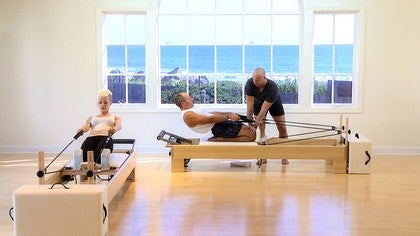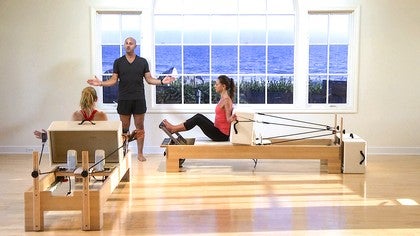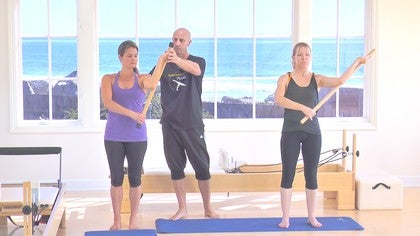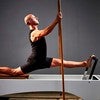Description
This is not your traditional Pilates class. The nature of stretching requires a slower, less dynamic approach. Anthony incorporates the technique sometimes called PNF, Muscle energy or Contract Relax to facilitate deep stretching and release of the whole body muscle. Patience and willingness will be the markers of change here. Enjoy!
About This Video
Transcript
Read Full Transcript
Hi everybody. I'm Anthony Litt from Australia and we're going to do a full body stretching work workout today. So we're going to start with the feet. We're going to work up through the muscle groups of the legs, then we're going to work on the spine and we're going to try and move the spine in all of its ranges of movement. And um, if we get time, we'll also do a little bit of stretching for the neck and um, the shoulders as well. Okay. What I might do, um, to start with is have Ruth lie down on here and Andy, if you'd lie down here, the stretch that we're gonna do first is for the carves and we need quite heavy resistance for this. So Ruth, I'm going to put, um, I'm going to put all the springs on and if it's too strong you can tell me and I'll adjust it for you and Andy. We'll do the same thing. Um, before we get started, I want to just remind everyone that stretching is a slower, less dynamic form of exercise than your conventional Pilati sessions. So you have to approach this class with a slightly more patient attitude or a slightly different mindset than you would if you were pushing yourself strongly in a more dynamic class. Um, the other thing that I wanted to mention briefly is one of the, the critical techniques of what we call innovations in [inaudible]. And that is this technique.
It's sometimes known as PNF or muscle energy technique, or simply contract relax. And how the technique works is that we take a muscle to a position where, or a muscle group, because we have to remember that we're never really stretching just one muscle. We take our muscle into a position where we feel a mild stretch, and that can mean on a, on a scale out of 10, possibly five or six out of 10, and we hold that position for about five breaths. Then what we do is we contract or activate the muscle that we're stretching or the muscle group that we're stretching. So that'll, this will become a bit more clear once we're actually doing the exercise. But for example, if I take my finger into a position where I feel a gentle stretch and I hold that for five breaths, then what I do is I activate the muscles that I'm stretching and to do that I push my finger into a barrier. In this case it's my thumb.
In the first stretch, it's going to be the bar itself. We do that for five seconds and once we've done that, we stopped contracting, we relax and as we breathe out we should find that we can re stretch maybe a centimeter or half a centimeter further. One other thing is that when you do the contraction, you don't use too much force, so we use 30 to 50% maximum force, so let's try that. Now with the stretch for the, so I'll have you guys if you can stand with your, if you can lie, sorry, with your feet roughly in line with your bottom bones and Ruth, maybe just a little bit wider for you. Sorry, your bottom just a little bit wider. If you can push them, if you can push the carriage out slowly placing the balls of the feet on the couch, on the bar.
And then what we're going to do is bend your right knee slowly and let your left heel drop underneath the bar. That should be your first position. And Are you both feeling a stretch? Yeah. Okay. So how strong is the stretch? That's the next thing you need to make sure that it's not too intense. What would it be? Seven. Okay, so we can, we can stay with that.
So we're holding it for five breaths. And then what we're going to do is maybe for this one so that people at home who are doing the same stretch can see if you can put your hand under the bottom here so that the carriage doesn't move. And what you're going to do is push the ball of this foot into the bar and that's going to activate our calf muscles. But we make sure that you heal, it doesn't come up. So let's do that now. So we push in for a count of one, two, three, four, five stop before your restretch take a breath in. And then as you, as you breathe out, relax and try and let your heel drop further underneath the bar.
And I noticed that Andy, you moved probably about this much further, so that's fantastic. Don't, don't try and push it any more than that. Just hold that stretch now for 10 breaths and try as much as you can to let your body relax. If you have happened to have a partner with you, the partner can hold onto your heel this way and just lean back with a little bit. Can you see how I'm pulling the carriage in just a little bit further? How is that? All right. The other thing that you can do, because it running down the back of your leg here, you have muscles running in slightly different directions. So what you can do to vary where you feel the stretch is, change the position of your heel. So if you turn the heel in slowly, you might feel the stretch slightly differently.
That any different
So it's really important to slowly explore the stretch. It doesn't have to be done quickly. Explore it so that over time you find your type positions and that's what's really critical in stretching that you're able to get on the reformer and find your spots and do the stretches that work for you. Okay, so let's lift that heel up and then slowly lower the other heel. It's important that you lower the heels slowly because if you go too quickly, your muscles will respond by actually contracting. And that's counterproductive to what we're trying to achieve.
So you need to move into the stretch really slowly so that the muscles don't resist what we're trying to achieve. Yeah.
Good. The reason that we re stretch on a breath out is that we find that your body has a little bit less tone and is a little bit more relaxed as you're exhaling. So that's, that's why we do that. I'll just pull on your heels slightly. You can tell me when to stop. That's enough. And if you want to try the variation again, you can do that, but it must be done very slowly so you can turn the heel either inwards or outwards.
So if you can push the carriage out and uh, stay lying down, but push the carriage out. Am I going to put just one foot in the strap? So put the strap over there. Just wait there for a moment and I'll talk you into the stretch. When you're doing this, you have to be careful that you don't take your leg, just bend your knee there. Andy, you have say some people who aren't as flexible as you, if they go straight into this position, it's going to be too strong for them.
So to get into the stretch, push your leg forward. This towards me. Yeah. And let the carriage come in, come out. Let's call that the starting point. Then slowly take your leg up very slowly with the other legs dying underneath the bar and without this one bending. So this leg stays straight up until you start to feel a stretch.
Is that a stretch? So you can, again, you can hold the carriage if you feel like you need to so that it doesn't keep moving. And that's why spring tension is important. If it's too strong, you're going to be pulled into a stretch that's too difficult. How does that feel? Okay, and notice that the other leg is staying horizontal. That's to make sure that we keep that pelvis stable there and it's not rolling backwards too much. Okay, so that's the first position. So we've held that for about five breaths.
Now we're going to do a contraction. So to activate the hamstrings and the glutes, because we're stretching the glute muscles as well. Here what we try and do is pull their leg down towards the other one, but we don't let the carriage move. So let's do that now. So Paul, five, four, three, two, one, take a breath in. And then as you breathe out, let the carriage slide in a little more and let you let go back to the, the next position. How does that feel Ruthie? Okay, there. Yup. Then we hold that again for 10 breaths. Try and relax. As I keep saying, the more relaxed you can be, the better the stretch, the more tension in your body, the less likely it is to let you stretch. Yeah.
I'm going to show you a little variation of this, which brings the stretch into the hamstrings on the outside of your foot. Your fi called the biceps femoris and the outside of the calf. This is quite intense. So go slowly and um, take it easy. So I know that Ruth loves this one. So slowly take your leg across your body without lifting, without lifting your hip. So towards the midline of your body. You can see the tongues hanging out here, but they're in some pain. So, um, where are you feeling this adding more here? Yeah.
So this, this is a stretch for the glutes. Some of the hip muscles here, hamstrings and outside of the calf. Okay. Now we're going to do another contraction. So hang on, I'll hold the strap and, and if you push your leg over towards Ruth, five, four, three, two, one, stop. Take a breath in. And then as you breathe out, take your leg of further across your body. As I said, it's quite an intense stretch, so don't make it too strong.
It should be on a pain scale of about five or 600. Try and relax and just enjoy those pleasing sensations. Okay, I'll show you how to come out of this stretch. Put your other foot on the bar. Straighten that leg. Yeah, so you'll get some slack in the ripe. I'll take this one down and I'll come around here and pos you the other strap.
So pop your foot in there. Remember not to go straight up into the stretch. Push the leg forward first. Use Your hands if you need to on the side of the reformer. Once you've got that leg straight, then slowly let you let go up into the stretch. So not too strong.
The first position has to be five out of 10 in terms of intensity.
Take a big breath in. And then as you breathe out, let the carriage slide in a little further.
Yeah. Not quite four weeks, but keep at it. So now let's try the variation of this. So before we do that, let's do, let's do the contraction. So you hold the ripe this way Andy, and you're going to push your leg. If you think of pushing towards the corner of the bar here, so it's down slightly down and slightly across, not using too much in too much strength. Yeah. So take a breath in and then raise stretch by taking your leg across the midline of your body without letting the other hip lift.
So keep those hips level. I'll just show you how to do this incorrectly in case someone's doing this at home. This why, so that's not really making the stretch any stronger. It's just rotating your spine. So keep your hips level and bring the leg across. Okay? Okay. I think Ruth's about to burst into tears. So let's, let's stop.
You can leave your foot in the air because the next stretch we're going to do is for your adopters, but we're going to have both feet in the straps this time. So what I'd suggest is that you bring your leg down first and then put the other one in the strap like Andy's doing. Push your legs forward. Good. Then slowly take your legs up to vertical and hold. We haven't started the stretch yet. This is just the beginning position.
The watch you need to do here is moving to the stretch position very slowly. Otherwise, the muscles on the inside of your legs will react by getting more tight, which is the opposite of what we're trying to achieve. So put your hands underneath the ropes and lift them upwards. Yeah. So push up so that when you take your legs apart, your arms are supporting the weight of your legs. Okay, so now slowly take your legs apart, holding ropes up, and let them keep going until you start to feel a gentle stretch between the thighs in the adductor muscles. You're feeling that now? Yeah, Ruth, I'm surprised too, getting a stretch already.
Now hold that there. And if you want, when you feel relaxed, you can take your hands off the ropes. You don't have to. It depends how it feels for you. It's interesting that you're more flexible going this way than that way. Now we're going to try the contraction. So this time, put your hands on the inside of the ropes. So what you're going to do is you're going to press your legs back towards the middle, but you're going to prevent the movement with your arms.
So let's do that now. So five, four, three, two, one stop. Take a breath in. And then as you breathe out, see if you can let your legs drop a bit further out.
One thing to remember is that when you're taking your legs apart, sometimes it's the medial hamstrings that prevent you from going further, not just the adductor him group of muscles. So we're going to try a little contraction for the hamstrings. So what to do is hold the rope again, both of them this time, instead of trying to pull your legs together, you're trying to pull your heels down towards the center of the bar. Okay, so down towards where I'm standing without letting your legs move. So let's do that now. Five, four, three, two, one. Take a breath in.
As you breathe out, see if you can drop your legs a little wider. Again,
We're gonna do a stretch for the group of muscles here, the gluteal muscles. So there's lots of them. There's the, there's the outer ones, and then there's lots of small muscles running underneath. So whether you feel this up here or slightly lower down, it doesn't matter. Anywhere in this region is where we're targeting. Okay? So what we'll do is, um, you can put the heel of your foot on the bar this time. Push the carriage out about three quarters of the way.
Good. Then lift the other foot and fold the leg across like that done. Let the carriage come in just yet. Hold that still. One thing that's important here is that as the carriage comes in, you maintain your lower back in a slight arch and you don't let the tailbone lift, otherwise you may not get much of a stretch. So with that in mind, bring the carriage in slowly by bending this knee, keeping those hips level.
And at some point you might start to feel a stretch in the gluteals of this leg, the top leg. Can you feel that? Yeah. Yeah. And Ruth. Yeah. Good. So again, remember you just bring the carriage in until you're feeling a stretch, which is about five or six out of 10 on the scale of intensity. Hold that. Still try and relax. You can let your toes relax. The more that your body is soft, the more effective the stretches will be.
So they try and through a little scan through your body and notice which parts of your stiff or title bracing. See if you can let those go a little bit.
The tail bones on the carriage and your hips haven't moved this way, so hip's not higher than the other one. If you find that your characters come all the way in and you're not getting a stretch, you can either put the bar up to a higher position or if you've got a block, you can put a block in here between your heel and the bar or you have to watch the next class, which is the advanced one. All right? Yeah, stay tuned. So let's, let's push the carriage out now and we will put, take that foot off and put it back on the bar and then we'll swap legs. So I'll just show you in terms of where to place your foot. Don't put this part of your foot here because it might be the ankle joint that ends up bending. Put your foot a little bit further over so that the, the, the hinges are carrying at the hip.
I'm going to show you two versions of this one. Um, actually no I'm not. I'm just going to do one and we'll see whether you can manage it. And if you can't, I'll give you a more simple version. So for this one, if you put the bar down like this, um, what I might do is demonstrate this for you first. So I'm going to have you on the carriage like this and I'm wondering if I can just move that out. Yeah, this time we need only about, um, probably what we would describe as medium resistance of the springs.
We'll put your heel on the bar here and both hands inside the front leg like that. Then we're going to move the carried out so that the angle of this front leg is just wider than 90 degrees and then the front leg doesn't push any further. If you do end up pushing further like this, it'll become another hamstring stretch. And that's not what we're trying to achieve at the moment. We're trying to achieve a stretch for the front hip of the rear leg, which I'll show you a bit more clearly when I get off.
So we're pushing out to here and then we're going to sink our hips down as low as we can. That'll be the first position. So I might just, um, stop there and get you to get into that position. And then I'll describe the rest of the stretch once you there. Okay. So I think Ruth, if you have one blue and one, okay, we'll have a yellow and a blue. I'll move the bar out of the way. And you put your foot up on here? Yes. Yeah.
Take off the red one, Andy, I'll come around this way so that everyone can see. So if you start opening out the angle of this leg first, Yup. And then hold still and push your back leg back as far as you can and sink your hips. Can you see how I'm pushing his hips down like this? And you should be feeling a stretch. And He, the front here, this region of this leg, is that where you're feeling the stretch? Good. So let's hold still there. And the same with Ruth.
You can see that Ruth's hip flexors are quite tight because they're preventing her hips from sinking down. And I'm going to be really gentle, but I'm just going to push down a tiny bit on her hip. How's that? Yeah. And also her hips are slightly s in this direction. So if you can make sure that they're square to the line of this leg. So bring this hip forward, rotate your pelvis this way and hold. Okay, so we're, we've held that for five breaths.
So now we're going to do a contraction and to activate the muscles that we're stretching here, the hip flexors, we push the back leg without moving the carriage. We push your back leg down into the carriage for five, so I'll just put my foot there, Andy. So the carriage doesn't move. You push foot down and this knee and this foot directly down into the carriage. So one, two, three, four, five, stop. Take a big breath in. And then as you breathe out, raise stretch. Not necessarily by pushing the carriage out, but just by lowering your hips a little more.
You should have someone helping you. They can lean a little bit onto your hips, but usually just sinking them down on your own is plenty. How does that feel? Both of you? Amazing.
I might just get Andy to do this and if you can stay there, but put your right and put your left hand here and your other hand here. Now without lifting your hips, what you do here is a contract. Let's just let me talk you through that contract the quadriceps so that your knee comes off the carriage. Even if it's just that much without lifting your hips. So just put your knee back down. Andy. I'm going to hold your hip still now. Try it again. Good. Now hold. Good. How does that feel?
It's quite intense. He said so I didn't tell you when we started, but this spreads here is one that we hold for about 60 minutes.
Okay, so hold a little longer. So now we're going to do another contraction. So Ruth, if you can, without moving anything, push your back foot and your back knee straight down into the carriage. So one, two, three, four, five, stop. Take a breath in. And as you breathe out, just lower your hips a little more. It's the lowering of the hips that extends this back leg and makes the stretch a bit stronger.
Good. Alright, enough. Good. So put your knee down and bring the carriage in slowly.
We're just going to do one more stretch for the legs. And that's for the quadricep muscles, the ones that run down the front of the legs here. Um, so let's, um, let's do what we call the kneeling quad stretch. What you need to do with this one is leave the bar down as it is, but you need to put all the springs on because we don't want the carriers to move very much.
And as you do that, you should feel the stretch right through the quadricep muscle group down the front. Okay. Some of you might feel some discomfort on the front of the foot here at the top of the foot. If that's the case, you can always put your foot just over the back of the carriage like this. But if it's not too uncomfortable, I'd suggest that you leave it there because it'll be stretching a group of muscles that run down the front of the Shin here as well. Okay? So let's get you into that position, all the springs and then turn the other way. If it feels uncomfortable on your knees, you can stop and again, you'll just have to watch the next class for another variation. Okay, so hold still legs together.
Can you get your legs a little more parallel? Any? Yeah. Good. So before you do anything, Tuck your bottom under and roll your pelvis back and then it has to stay that way. Ride through the stretch. That's good. So tell me tight and now you're in that post area tilt. You can start leaning backwards until you feel the stretch down the front of the thighs. Anything yet, Andy? All right. Just make sure you maintain that tuck.
If you can draw the shoulders down from your ears. How does that feel, Ruth? Yep. So tuck and if you have a partner, of course I'll come around this way. That can hold your knees down a little bit as well. Yeah. How's that? Okay, so let's do a contraction.
So we're going to push your feet down into the Cary. So one, two, three, four, five, stop. Talk again. And on a breath out. Lean a little further. Try and keep the knees together.
How's the stretch? Okay, it is a bit stronger if someone pushes down. I'll just do that for you. How's that? Yeah. Now we'll do one more contraction. So push this time. Push your thighs up into my hands. So this time we're activating your hip flexors and relax. Talk again, and go a little further if you can.
Good. Okay. Now come out of the stretch slowly. So curl forward and good and then gradually sit up. Okay, very nice. So that's, I think that's enough for, um, the legs. Let's move on to the trunk. We're going to try, as I said, to move the spine through all of its planes of movement. So that means side bending, that means rotation. It means back bending and forward bending. So let's start off with, um, quite a gentle stretch for the side of your body. Some of the muscles that run around this area, I bleaks, they're called and quadratus, lumborum and so on.
I might demonstrate again first, um, for this one, put the bar up to its highest position and the spring tension needs to be minimal here because you don't want to be fighting against a character that's trying to pull itself back in. So not too strong. The first thing that we do is sit comfortably and make sure that both sit bones stay on the carriage. If you can feel them through the flesh that's underneath. So push the carriage out gently and then reach up and over with the outside. Um, if this happens, you're not gonna find much of a stretch. So keep this side down.
Lift your chest and reach over and you'll notice that I'm letting my head relax as well and hold. So let's start with that and then I'll talk you through the rest. So Andy, if you want to sit on there, I'll take all those springs off and put, so sit comfortably. That should be okay for you. Yeah, if you one, so good. So Andy, if you start by pushing the carriage out and then reached the other arm up and over, you can do the same roof. Good.
And you can lean as far as you like, as long as it's comfortable. And as long as this heap is staying anchored, you're both feeling a stretch there. Yeah. So as far as breathing goes here, the deeper that you can breathe, the more that your diaphragm will be able to force your abdominal content out and the greater the stretch. So deep breathing is good. It'll also stretch the muscles between your ribs. And the other thing to be aware of is that your spine is articulating rather than just bending at one point.
So make sure that you try and Ilan Gaye and bend and move your ribcage that way. So Andy, I'll, I'll show you what I mean. Just stay where you are, stay where you were. But imagine someone's pulling your ribcage across this way. Can you feel how that makes it a bit stronger? Yup. Okay. Now, once you're in position, remember those muscles running this way, this way and this way. So as I said before, you need to explore the stretch a little bit. You can try rolling your shoulder back just a little and focus the breathing as much as you can into here.
And that should move the stretch into your lats, the muscles under your arms a little as well.
Okay. And bring the carriage back in.
Put your hand in, in the middle of the bar and move the carriage out slowly. This will be a nice angle to see the shape of your spine. So reach the arm up and over. Good. And as I said, make sure that this hip stays anchored and that you as much as possible, move your ribcage across towards me.
This time I'm going to show you how to do a contraction as well. Um, if you're on your own, it's very simple. If you have someone with you, it's the same thing. Just lightly pushed back into my hand. One, two, three, four, five. So Ruth, you just imagine you're pushing it to someone. Take a big breath in, exhale and reach over a bit further if you can do it and keep that hip down. Yeah, good. Now remember variations here so you can roll the shoulder back slightly and exaggerate the breathing into here and now try the other direction. So roll forward.
This is a nice counter movement to those exercises. So what we do is sit not quite arms length but about this position from the, from the shoulder, wrists, and again, roll your hips backward first. So post area tilt and at the same time pushing your arms forwards and upwards into the shoulder, wrist. So it looks like this slump and
The spring tension is not really important here because we're not going to be moving the carriage. So sit about not quite arms length. That's good. Let's start off with slumping the hips. Good. The usual position that most of us are in at our desks or while we're watching TV, unfortunately. Now tighten the tummy and then push the hands forwards and upwards.
And the stretch should extend from here all the way down to possibly to the lower back. But a lot of the time you'll feel it between the shoulder blades. How are you both feeling that? Yeah, so the chin goes down towards the chest. The more that you can contract those abdominal muscles, the more flection get getting your spine and the stronger the stretch. Now, very slowly, if you can take your ear across towards your shoulder, you might feel the stretch on one side of the neck and slowly go to the other side.
And it also stretches the muscles that run between your shoulder blades. So it's very popular for most people who come into the studio. So I'll show you what it looks like and then you can have a go. So with this one, we sit roughly, um, I bleakly so not parallel with the bar, but on a slight angle. And again, we're going to slump and the arm that's on the outside holds the sidebar and the other one goes like this. And so he slump.
Lean back, pulls strongly with this arm and push strongly with this one. So it looks like this, and although it doesn't look like I'm doing much, the muscles that are running between my shoulder blades, they're getting stretched really strongly. So let's have a try of that and see how it feels. So sit slightly on that angle. And again, not quite arms length from the bar. Good. So start sitting up tall so that you can feel the contrast between a nice posture and a slump.
And if you grab here with your left hand and the other one here, roll your hips back, flex the spine and lean back towards the back of the reformer. Push and pull. Just shift your weight over a bit so you're leaning directly back rather than across towards me. Great. So Ruth's pulling with this arm, pushing with this one slumping and the stretch be felt somewhere around here. You can't quite see her shoulder blade, but it's been pulled from here across to here.
And the muscles that are running in line with my fingers are being stretched. Good stretch. You're both feeling that good. So let's do a contraction. So imagine you're gonna draw your shoulder blade back towards your spine like this without actually letting it move. So one, two, three, four, five. Breathe in. As you breathe out, relax your arms laying back. Then again, you can pull with this one and push with this one.
Okay. Slowly relax. Relax the arms first. And always come out of these stretches slowly. Because remember, we're not just stretching muscles, but the discs in your spine would have been moved posterially there. So you have to come out of it very carefully. All right, we'll do the other side. Good. So Ruth, imagine that you're leaning towards the very back of the reformer.
Now if he can again, push with this arm, pull with the other one. Okay, so let's do a contraction again. So Andy, the action is for you to try and imagine that your shoulder blade is being drawn towards the middle of your back. So it's this retracting action for the shoulder blade. Let's try that. So one, two, three, four, five, take a breath in. As you breathe out. Slump. Pull with the outside arm.
The one that's on the side bar and push with the other one.
So you might do two stretches on that side and one on the other one. Okay. Now we, the only thing that we haven't done so far is a backbend and we might do a gentle one on the reformer. Um, what we need is the bar. You can probably leave where it is, but we just need a couple of mats to drape over the, um, the foot bar. And once we've got them, we, let's put some more springs on to, let's put all the springs on because we don't really want the carriage to move. Sorry. Yeah, I'll come and get those mets. Thanks. Okay, so I'll just, um, first set up here with Andy.
If this feels uncomfortable on your back, then you can leave this stretch, but let's give it a try and see how it feels. So Andy, what I'm going to do is if you can hold the mat there, I'll just demonstrate first, I'm going to sit quite close to the end or s actually the start of the carriage. And then I'm going to lie back over towards the bar and using my hands to crate on my head. I'm going to lean back this way.
All right, so let's set that up. The reason that we're using the mat is that we want to have a bit more support for your head and neck.
Don't take your head back fully. Just cradle your head in the hands until you feel like you're getting a gentle stretch, mostly in the upper back
Actually, the first one, we don't need a box. We're going to stretch some of the rotator cuff muscles of the shoulders. So the muscles that we're stretching here, they're the ones that turn our arms outwards. And you'll feel this stretch usually quite precisely around the top of the shoulder here. It's the infrast Bernardis muscle, and there's a few other ones as well, but I'll just demonstrate it to you first if you sit this way and put, so Andy, you're going to use the opposite strap. So the one opposite here, put this strap just above your elbow and then you put your hand behind your lower back. This way. Okay. And what's going to happen is as the carrot slides in, my elbow will be drawn forward and the stretch will come about through here.
Okay? Those springs, or I'm using my feet also to control the movement of the carriage. Okay. Those springs are too heavy though. Let's start off with some mediums. Springs. So Ruth, I think just um, yeah, yellow and red. And because you're a big bigger Andy, you'd have, you've got a blue and a red. Okay. So push the carriage out.
Now let the carriage slide in and let your elbows be drawn that way until you start to feel a stretch around here. Okay.
Yeah. To come out of this t, um, move the carriage out a little further using your feet. Yeah. And then take your arms out of the straps. Okay, so good. So let's just do one more stretch before we finish. For the muscles of the forearms, which are often very tight and especially for use a lot of computers, computer work and things like, um, um, thoracic outlet syndrome and swelling of the forearms are often the result of very tight muscles. So I'll just, let's do a little stretch using the reformer for the lower, the lower flexes of the arms. So this one here, take off Ruth, if you hop up and take off all the springs, and for this one we're going to stand inside here and put all of our hands, including the heel of the hand. All of them, like not half of them, all of them on the carriage like this, including your fingers with the fingers spread. Okay?
So let's do that and then I'll talk you through the rest of it. So palms of the hands and all of the fingers go and make sure your fingers are not hanging down the back of the carriage. Good with your arms straight. Now Lean as if you've got one long bone going down here. Lean directly down into the hands and then just very carefully slide the carriage out so that this angle, this angle get smaller. Okay?
Don't push too far. Hold still. So it's important that you don't lift the hand up, otherwise the stretch is going to disappear. Okay? So we're going to do a contraction. So push all of your fingers and the palms of your hands down into the carriage. So one, two, three.
Remember not using too much force for five. Stop. Take a breath in. And then if you want to make it more intense, slide it out a little further. Now before you stop, let's lean your body weight above each finger. So lean above this thumb.
Then the next finger. So you're going to be moving around in a semicircle, one finger at a time. We're getting very precise in our stretching. One finger. You didn't think you'd be doing finger stretches, did you? So one finger at a time until you get to the other hand. And then slowly above each finger until you end up at the thumb.
Then come back. So move your body weight back to the middle. And to come out of this stretch, try not to push downwards. Try and just lift up gently and let your arms hang. Give them a bit of a shake.
Stretch & Release: Innovations in Pilates
Comments
And the Aussie humour made me giggle :)
You need to be a subscriber to post a comment.
Please Log In or Create an Account to start your free trial.






































